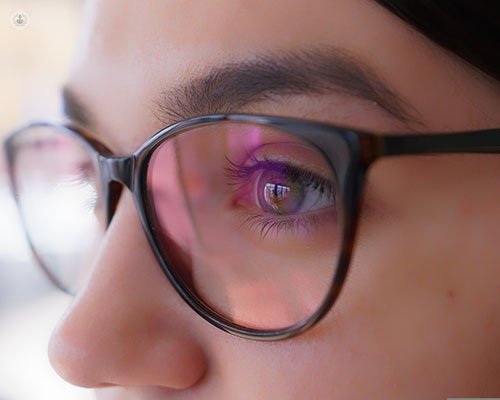Macular hole: your questions answered
Written by:A macular hole is an eye condition that can cause blindness if left untreated. In our latest article, renowned consultant ophthalmologist Mr Craig Goldsmith answers the most frequently asked questions regarding this condition.

What is a macular hole?
A macular hole is an eye condition in which a hole or gap develops in the centre of the retina. The symptoms of macular holes include blurry vision, and distortion when looking at straight lines or letters. Some people also experience a small circle of missing vision right in the centre.
A macular hole is not the same as age-related macular degeneration, although in some cases people can have both macular conditions in the same eye concurrently.
What causes a macular hole?
Nobody is sure what causes macular holes. They commonly occur in people over 60 years of age and are more common in women than in men. It is also more common in long-sighted people.
There are some other possible causes too: a previous retinal detachment, trauma to the eye, and short-sightedness.

How are macular holes treated?
Macular holes are treated with a vitrectomy. This is a procedure in which the vitreous fluid in the eye is removed by a surgeon and replaced with another fluid. This procedure is used to treat several different eye conditions. When done to treat a macular hole, vitrectomy has highly successful results, especially if it is done within the first few weeks of the macular hole appearing. It will close the hole completely in over ninety per cent of cases.
Even if the hole is not completely closed, many patients report a positive change in their vision after vitrectomy. The vision is stabilised, with less visual distortion and they can see much better in eye tests. However, vision rarely returns to normal levels.
The surgery usually takes around twenty to thirty minutes. Depending on several factors, it can be done either under local or general anaesthetic. The surgery is usually done as a day case, meaning patients can go home the same day after the surgery.
Are there any risks to macular hole surgery?
As with any surgery, there is a risk to vitrectomy procedures. One of the risks is an infection in the eye, even though this is considered very rare. Another rare complication is bleeding in the eye. Although both of these complications don’t happen very often, they are very serious. Both can lead to blindness if left untreated.
Another much more common complication of macular hole surgery is cataracts, which cause a cloudy lens. If the patient undergoing macular hole surgery has not previously undergone cataract surgery, cataracts will almost certainly appear after a vitrectomy. As cataracts are inevitable, patients are sometimes offered a combined vitrectomy and cataract extraction surgery in one procedure.

Another possible complication of vitrectomy is retinal detachment. This is a serious complication, in which the retina detaches from the back of the eye. This can be treated with further surgery, although in some cases it can cause blindness.
A more common complication is raised pressure within the eye. This usually subsides after a few days, and symptoms can be improved with eye drops or medication. If the high pressure does not subside after a few days, there is a risk of damage to the optic nerve.
What is the recovery period of the surgery like?
In most cases, you can go home the same day as the operation. After the surgery, there will be a gas bubble in your eye. Some patients will have to stay in a face-down recovery position after the surgery. Your doctor will tell you if this is necessary, and for how long you will have to stay in this position. Most patients will have to stay home from work for 2 weeks, as the gas bubble in the eye can affect your vision, and distort your depth perception.
It is also recommended that patients refrain from flying until the gas bubble has absorbed, which can take from three to twelve weeks depending on the type of gas used. This is extremely important, as the gas bubble can expand with altitude, causing severe pain and permanent blindness. Patients will be able to notice the gas bubble shrinking in the weeks following the surgery and will know when the bubble has been completely absorbed.
If you are concerned about a macular hole or any other eye condition, please don’t hesitate to book a consultation with Mr Craig Goldsmith via his Top Doctors profile today.


